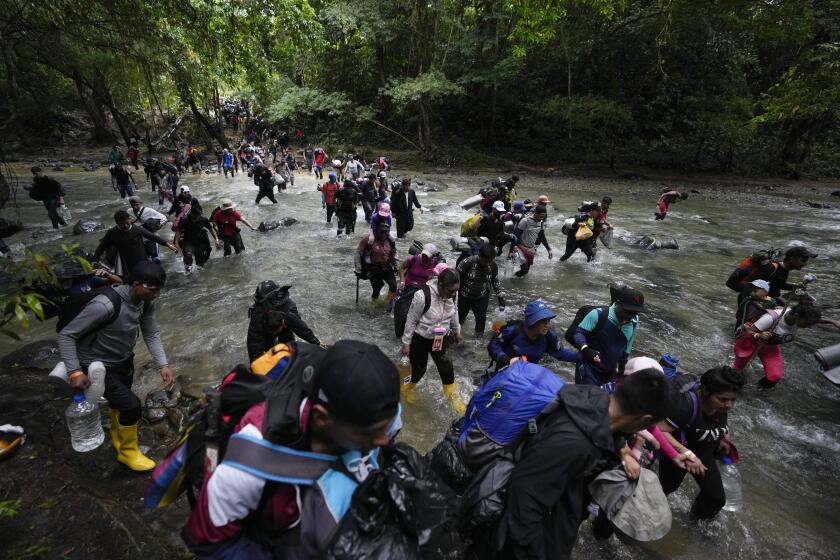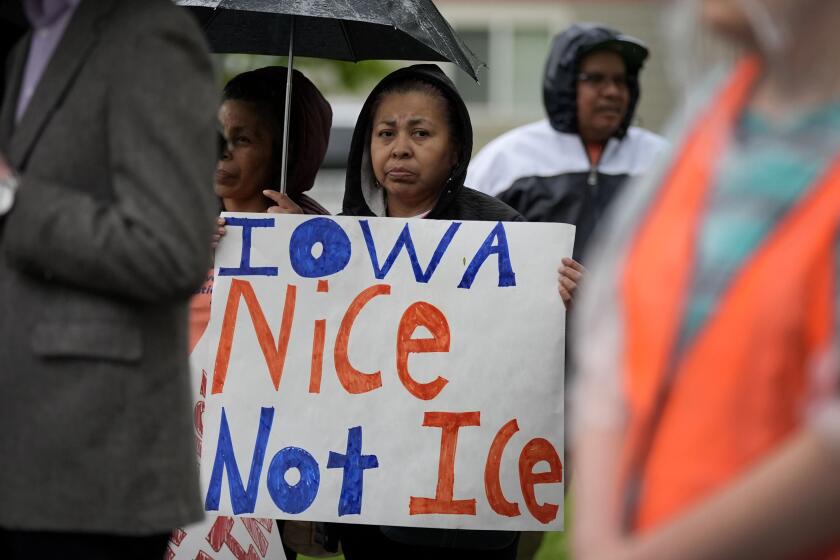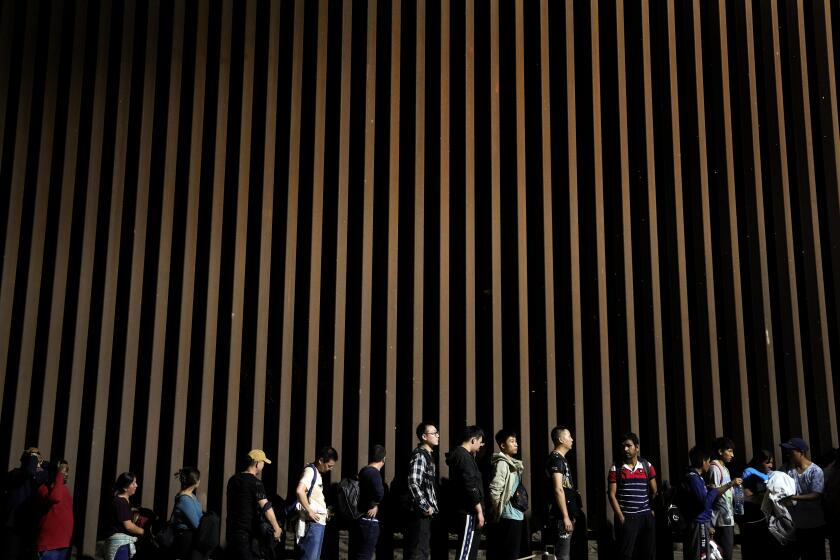U. S. Borders Vexing for Bi-Country Tribes
A dried cactus trunk clacks softly against the tiled hallways on Capitol Hill as Ruth Ortega shuffles from office to office.
She calls it her “prayer stick”--a walking stick nearly as tall as she is, with bright ribbons around the top--and she has brought it some 2,000 miles as she and other members of the Tohono O’odham Nation ask Congress to right a wrong.
For centuries, the Tohono O’odhams moved freely around their dusty lands in southern Arizona and northwestern Mexico. Even after the U. S.-Mexico border was formalized in 1853, white markers on the dirt roads were the only reminder of the boundary.
But since the mid-1980s, a barbed wire fence has sliced the reservation in half, and the tribe has been caught in the middle of aggressive efforts to choke off illegal immigration and drug trafficking.
“It’s a real problem,” said Henry Ramon, vice chairman of the tribe. “It’s a war zone out there on the reservation.”
The tribe claims that the border issue is splitting families, preventing members from getting adequate health care, denying government benefits to some and hindering the practice of the tribe’s religion.
The Tohono O’odham Nation spans an area about the size of Connecticut just west of Tucson. It’s the second-largest reservation in the United States.
It has about 24,000 members on its rolls. About 7,000 of them living on the U. S. side, especially older members, can’t prove that they were born in the United States and are technically illegal immigrants. They can’t legally work, get driver’s licenses, Social Security or travel south to visit family or sacred religious sites in Mexico.
Another 1,400 members of the tribe were born and live in Mexico, and it is difficult--and in some cases impossible--for them to go north to get medical help or visit family.
“Traditionally, we were born in our own homes because of transportation [problems] and also because that’s our way of life,” Ramon said. “Now we’re being punished because we don’t have a birth certificate.”
The Tohono O’odhams are not the only tribe struggling with border issues. Half of the St. Regis Mohawk reservation falls in New York, the other half spills into Canada, creating commerce problems from one side to the next. The Blackfeet tribe has similar problems on the border between Montana and Canada.
The Kickapoo tribe in Texas had border disputes similar to the O’odhams until a 1983 law granted them permission to cross the border freely.
The Kumeyaay tribe in California is working with the Immigration and Naturalization Service on border agreements.
“If you look around throughout the northern border, throughout the southern border, we have consistent examples of native communities divided by nonnative boundaries,” said Keith Harper, an attorney with the Native American Rights Fund. “There is little difference between the people culturally, spiritually, politically. The only difference is one happens to be born in the United States and it just causes a lot of difficulties.”
When she was younger, Ortega remembers the trips to her grandmother’s house in Mexico and the first time they were stopped by Border Patrol agents on horseback.
Today, off-road vehicles rumble across the desert patrolling the fence line, and if Ortega visits her grandmother’s grave, she risks being stopped, searched and possibly deported.
For some, crossing the border is a matter of life and death, said Lavern Jose, one of several women who shuttles sick and elderly Tohono O’odhams from Mexico to an Indian Health Service clinic in Sells, Ariz., the reservation headquarters.
She said four people died because they were turned back at the border and couldn’t get the help they needed.
Once, she and an elderly patient scheduled for eye surgery were stopped by border agents, one of whom drew his gun and aimed it at the van.
“I was just very upset because they had no right to do that,” Jose said.
Repeated attempts to reach a Border Patrol spokesman to discuss the incidents were unsuccessful.
Also off-limits are some of the tribe’s most sacred sites in Mexico, including a cave in the Pinacate, believed to be the home of I’itoi, the Creator who shaped the Tohono O’odham--which translates to “desert people”--from the clay of the arid land.
Elderly members who fought in wars for the United States can’t collect veterans benefits. Others can’t collect Social Security or health benefits because they can’t prove their citizenship.
“Make It Right” is the message on the lapel stickers about 10 Tohono O’odham members wear when they fan out from the Washington home the tribe is renting. The lobbying effort is being paid for mostly by the reservation’s casinos, which generate an estimated $52 million annually.
The O’odhams are backing legislation introduced last month by Rep. Ed Pastor (D-Ariz.) that would make the tribe’s membership card the only identification needed to prove citizenship, travel freely or receive federal benefits.
Jack Martin, with the Federation of American Immigration Reform, said the special tribal designation could complicate border enforcement. A simpler solution would be to issue border crossing cards to the immigrants, and it wouldn’t require an act of Congress.
“We don’t want to mess up the tribal movement in their tribal area, but we don’t think it’s necessary to, in effect, create a new citizenship document in order to take care of that problem,” he said.
Last year, the INS approved about 100 visas for tribal members. But the nation had to pay about $100,000 to process them, and members without birth certificates couldn’t get the visas.
Margo Cowan, an attorney for the tribe, said the government has treated the Tohono O’odhams on both sides of the border as if they were citizens since the tribe was recognized in 1937.
“The Tohono O’odham members should be U. S. citizens,” she said. “Anything else is just unacceptable.”
More to Read
Start your day right
Sign up for Essential California for news, features and recommendations from the L.A. Times and beyond in your inbox six days a week.
You may occasionally receive promotional content from the Los Angeles Times.






